Online presentation given at the Christian-Albrechts University of Kiel
The online lecture was given by Dr Viktória Kiss, the PI of the Momentum Mobility Research Group, detailing the methodologies, international collaborations and the results their work produced. The presentation was part of the Archäologisches Kolloquium series run by the Christian-Albrechts University of Kiel, Germany, 15th of February, 2021.
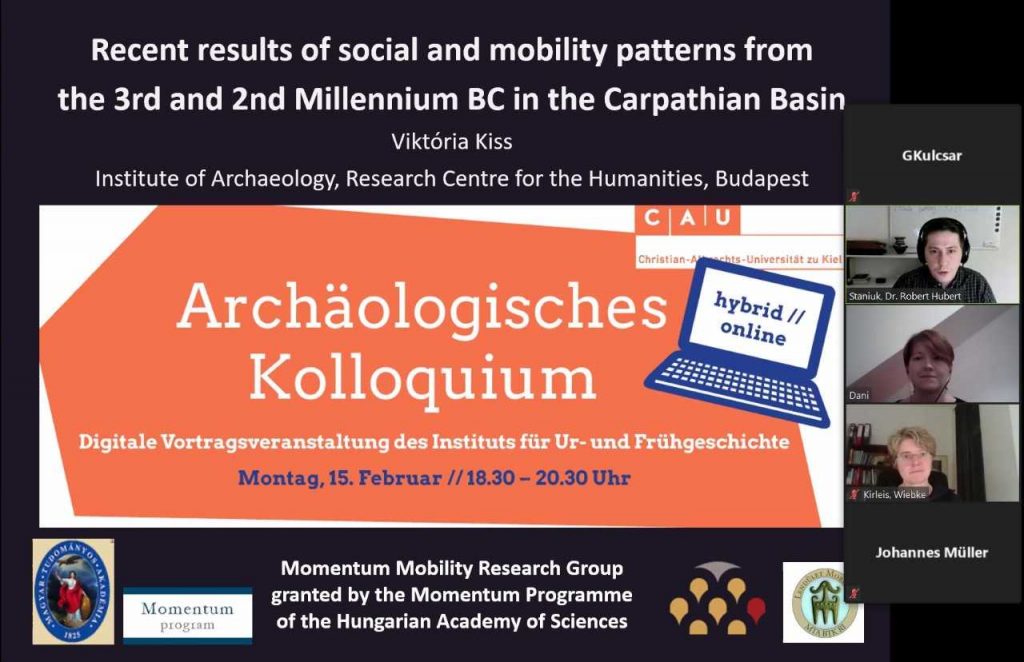
Bioarchaeological study of skeletal and cremation burials
The presentation summarised the research carried out on Early and Middle Bronze Age burials excavated in the central part of the Carpathian Basin, as well as on settlements, including the examination of metal artefacts. Bioarchaeological analyses conducted on skeletal and cremation burials were able to shed more light on the burials of children, gender identity and social inequality, through which the issue of settlement burials and evidence for Bronze Age violence were also touched upon. The results of these studies have recently been published (Dani et al. 2016; Gömöri et al. 2018; Melis 2020; Melis et al. 2020; Szeverényi–Kiss 2018; Szeverényi et al. 2020a, 2020b).
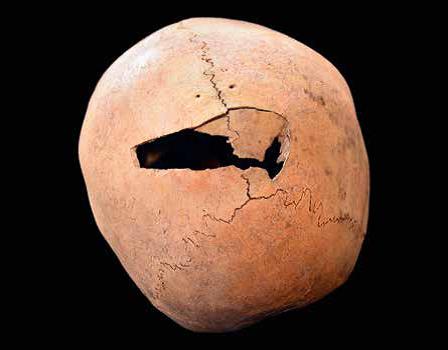
Érd-Hosszúföldek feature 806, perimortem injury on a 4-5 year old child’s skull (after Szeverényi et al. 2020b, Fig. 18)
Among the latest data there are 150 new AMS radiocarbon samples, thanks to which the number of modern absolute dates known from the Bronze Age Hungary have doubled (P. Fischl 2013, 2015; Kiss et al. 2019). The radiocarbon dating of cremation burials is a novel approach here, conducted in collaboration with the Atomki IKER laboratory for the first time in Hungarian Bronze Age research (Dani et al. 2019a; Kiss et al. 2019; Major et al. 2019).
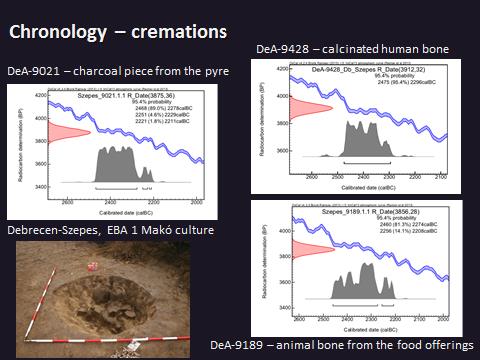
The physical anthropological study of cca 2000 cremated human remains have led to several interesting conclusions. Results suggest that the cremation of the body was usually carried out in the days following the individual’s death, with no prolonged treatment of the body (Király 2017). The cremated remains were then all collected; selection processes targeting certain parts of the body can only be observed during the later period of the Bronze Age (Köhler et al. in print). Sr isotope and aDNA analyzes performed on human remains imply that among the Early and Middle Bronze Age communities many non-locals can be identified; in some cases the ratio of non-locals can reach 40% of the entire dataset (Giblin et al. 2019). By this, several forms of mobility can be assumed: one-way immigration involving communities, where women, men and children can also be found among newcomers, e.g. in the case of Bell Beaker culture (Price 2004; Kulcsár 2011; Olalde et al. 2018). In the Middle Bronze Age, however, a greater number of mobile women can be observed, perhaps explained by exogamy, i.e. male members of communities chose their wives from more distant lands. Interactions are also indicated by trade networks (Kiss 2020a). In addition, international collaborative studies of burials of this period also examined the spread of cremation rites in Central Europe (Cardarelli et al. 2020).
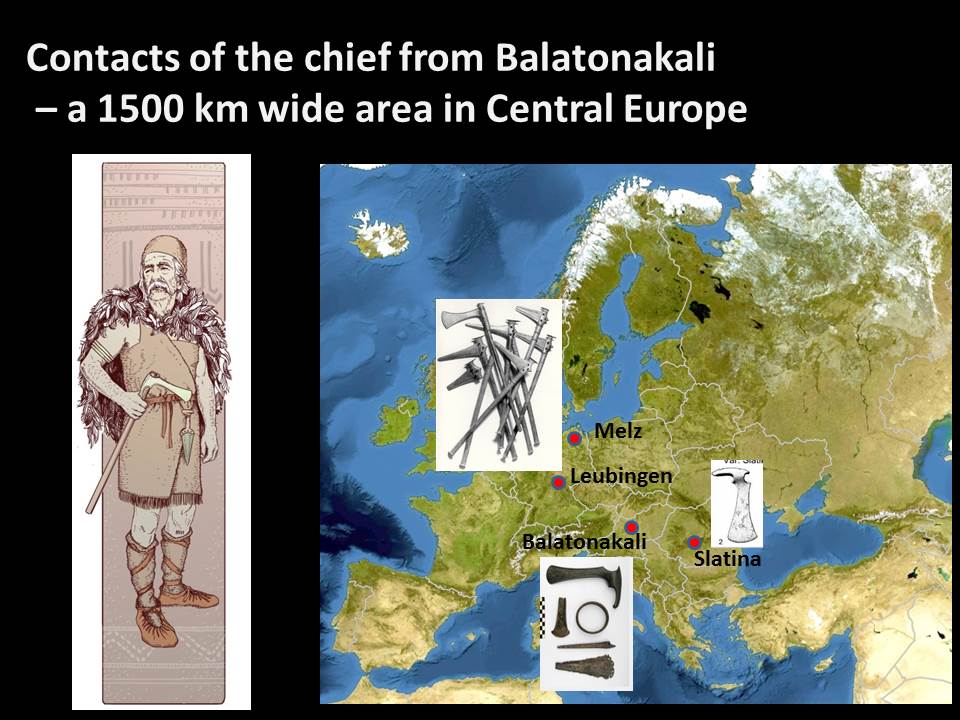
Microregional research, metallurgical analyses
The lecture covered advances of micro-regional research including modern GIS methods in the processing of archival and more recent settlement and cemetery data, and also field surveys using GPS and geophysical measurements (Gömöri et al. 2018; Jaeger et al. 2018; Dani et al. 2019b; Szathmári et al. 2019; Melis et al. in print).
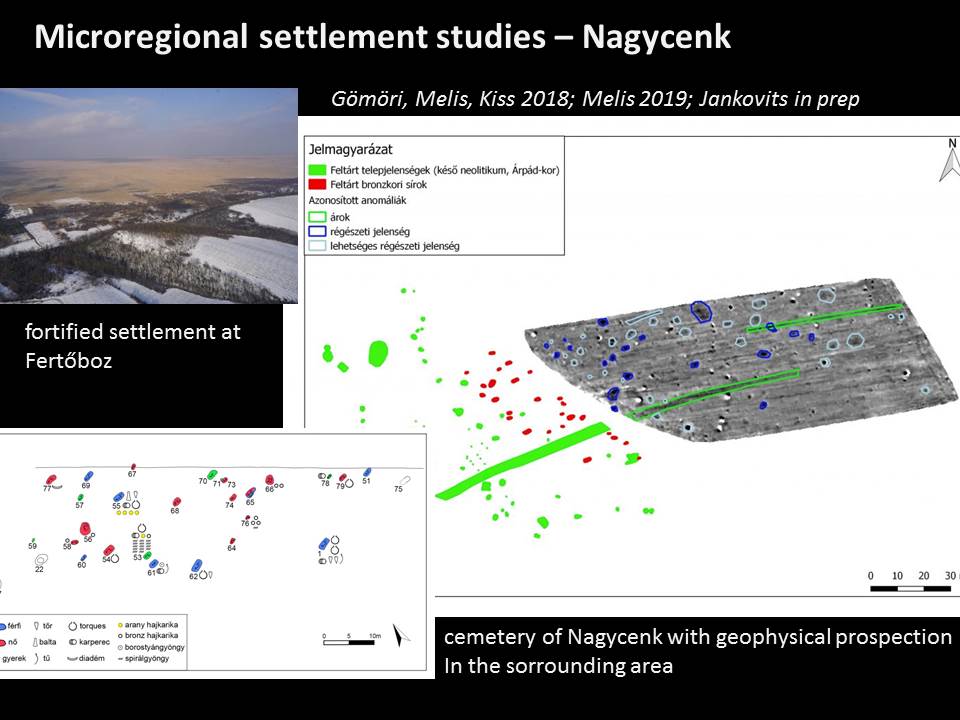
Tests carried out by the Budapest Neutron Centre revealed the production technique of metal artefacts, and implied the importance of regional ore sources and trade relations in both the Early and the Middle Bronze Age (Kiss et al. 2015; Maróti et al. 2017; Melis 2019; Szentmiklósi et al. 2018; Kiss 2020a, 2020b). Metallographic examinations of artefacts from cremation burials, in cooperation with the University of Miskolc and the University of Debrecen made it possible to establish that some ornaments were subject to secondary burning, thus these artefacts were placed on the pyre together with the deceased. Several other metal objects, however, were not exposed to fire, highlighting the complexity of burial practices (Kovács et al. 2019).

Copper and bronze grave goods from skeletal and cremation burials of the Bonyhád Biogas factory (after Kovács et al. 2019, Fig. 2)
Thanks to the invitation of an outstanding university in prehistoric research, the online lecture was followed from several countries, so despite the epidemic situation, it was a good opportunity to share our results not only with university students but also with European archaeologists.
References:
Cardarelli, A., Cavazzuti, C., Fritzl, M., Gavranovic, M., Hajdu, T., Kiss, V., Köhler, K., Kulcsár, G., Melis, E., Rebay-Salisbury, K., Szabó, G., Szeverényi, V.: The connections between the plains of the Po and the Danube during the Bronze Age seen through the spread of the urnfield model. In: Rivista di Scienze Preistoriche 70 (2020) – Numero speciale, Italia tra Mediterraneo ed Europa: mobilità, interazioni e scambi, 225–238.
Dani, J., P. Fischl, K., Kulcsár,G., Szeverényi, V., Kiss, V.: Visible and invisible inequality in Early and Middle Bronze Age Hungary. In: Meller, H.–Hahn, H.-P.–Jung, R.–Risch, R. (Hrsg.): Arm und Reich–Zur Ressourcenverteilung in prähistorischen Gesellschaften / Rich and Poor–Competing for resources in prehistoric societies). 8. Mitteldeutscher Archäologentag vom 22. bis 24. Oktober 2015 in Halle (Saale). Tagungen des Landesmuseums für Vorgeschichte Halle 14. Halle (Saale) 2016, 219–242.
Dani, J., Köhler, K., Kulcsár, G., Major, I., Melis, E., Patay, R., Szabó, G., Hajdu, T., Futó, I., Huszánk, R., Kiss, V.: Case studies on the radiocarbon dating of Bronze Age cremation burials in Hungary. In: Palincas, N., Ponta, C. (eds): Bridging Science and Heritage in the Balkans: Studies in archaeometry, cultural heritage restoration and conservation. Proceedings of the Fifth Balkan Symposium of Archaeometry 2016, Sinaia, Romania. Oxford, Archaeopress 2019, 29–37.
Dani, J., P. Fischl, K., Kulcsár, G., Szeverényi, V., Kiss, V.: Dividing space, dividing society: fortified settlements in the Carpathian Basin (c. 2300–1500 BC). In: Meller, H., Friedrich, S., Küßner, M, Stäuble, H., Risch, R. (Hrsg.): Siedlungsarchäologie des Endneolithikums und der frühen Bronzezezeit – Late Neolithic and Early Bronze Age Settlement Archaeology. 11. Mitteldeutscher Archäologentag vom 18. bis 20. Oktober 2018 in Halle (Saale) – 11th Archaeological Conference of Central Germany October 18–20, 2018 in Halle (Saale). Tagungen des Landesmuseums für Vorgeschichte Halle 20. Halle (Saale) 2019, 851–868.
P. Fischl, K., Kiss, V., Kulcsár, G., Szeverényi, V.: Transformations in the Carpathian Basin around 1600 BC. In: Meller,H., Bertemes, F., Bork, H-R., Risch, R. (eds.): 1600 – Kultureller Umbruch im Schatten des Thera-Ausbruchs? 4. Mitteldeutscher Archäologentag vom 14 bis 16 Oktober 2011 in Halle (Saale). Tagungen des Landesmuseums für Vorgeschichte Halle 9. Halle: Landesamt für Denkmalpflege und Archäologie Sachsen-Anhalt, Landesmuseum für Vorgeschichte. Halle (Saale) 2013, 355–371.
P. Fischl, K.–Kiss, V.–Kulcsár, G.–Szeverényi, V.: Old and new narratives for the Carpathian Basin around 2200 BC. In: Meller H, Arz WH, Jung R, Risch R (eds): 2200 BC – A climatic breakdown as a cause for the collapse of the old world? 7th Archaeological Conference of Central Germany. October 23–26, 2014 in Halle (Saale). Tagungen des Landesmuseums für Vorgeschichte Halle 12. Halle (Saale) 2015, 503–524.
Giblin, J., Ayala, D. Czene, A., Csányi, M. Dani, J., Endrődi, A., Fábián, Sz., Hajdu, T , Köhler, K. Kulcsár, G., Melis, E., Patay, R. Szabó, G., Szécsényi-Nagy, A., Szeverényi, V., Kiss, V.: Bronze Age Burials from the Carpathian Basin: New Isotope Results (poster). SAA 84th Annual Meeting, Albuquerque, New Mexico, U.S., 2019. April 10–14. Program book. Albuquerque 2019, 100.
Gömöri, J., Melis, E., Kiss, V. 2018: A cemetery of the Gáta–Wieselburg Culture at Nagycenk (Western Hungary). Acta Archaeologica Academiae Scientiarum Hungaricae 69 (2018) 5–82.
Jaeger, M., Kulcsár, G., Taylor, N., Staniuk, R. (eds): Kakucs-Turján. A Middle Bronze Age multi-layered fortified settlement in Central Hungary. Bonn 2018.
Király Á.: A terminológia halálától a halál terminológiájáig. Megjegyzések a temetkezés fogalmához és a temetkezési ciklus állomásainak nevezéktanához. Tisicum 25 (2017) 83–92.
Kiss, V.: The Bronze Age burial from Balatonakali revisited. In: Maran, J., Sorin-Christian, A., Bajenaru, R., Hansen, S. (eds.): Objects, Ideas and Travelers. Contacts between the Balkans, the Aegean and Western Anatolia during the Bronze Age and Early Iron Age. Conference to the Memory of Alexandru Vulpe. 10th-13th November 2017, Tulcea, Romania. Tulcea 2020, 553–568.
Kiss, V.: Transformations of Metal Supply during the Bronze Age in the Carpathian Basin. Hungarian Historical Review 9 (2020) 315–330.
Kiss, V., Csányi, M., Dani, J., P. Fischl, K., Kulcsár, G., Szathmari, I.: Chronology of the Early and Middle Bronze Age in Hungary: New results. In: Pavúk, P. (ed.): Reinecke´s Heritage. Terminology, Chronology and Identity in Central Europe Between 2300 and 1600 BC. Proceedings of the Humboldt Kolleg 12-15. June 2017, Křtiny, Czech Republik. Studia Hercynia 23 (2019) 173–197.
Kiss, K. P. Fischl, E. Horváth, Gy. Káli, Zs. Kasztovszky, Z. Kis, B. Maróti and G. Szabó: Non-destructive analyses of bronze artefacts from Bronze Age Hungary using neutron-based methods. Journal of Analytical Atomic Spectrometry 30 (2015) 685–693.
Kovács R. L., Gyöngyösi Sz., Barkóczy P., Juhász L., Szabó G., Kiss V.: Technológiai megfigyelések kora és középső bronzkori fém tárgyakról (Technological observations of Early and Middle Bronze Age metal objects). In: Vicze, M., Kovács, G, (szerk.): MOMOSZ X, Őskoros Kutatók X. Összejövetelének konferenciakötete, Őskori technikák, őskori technológiák. Százhalombatta 2019, 187–197.
Köhler K, Hajdu T, Czene A, P. Fischl K, Guba Sz, Király Á, Kővári I, Nagy N N, Patay R, Somogyvári Á, Szabó G, Vicze M, Kiss V, Kulcsár G: Understanding cremation burial practices in Bronze Age Hungary. In: „Cremation Burials in Europe between the 2nd mill. B.C. and the 4th c. A.D – Archaeology and Anthropology” Proceeding of the Conferemce held between 12th-15th October 2017, Münich. Ed. by Carola Meztner-Nebelsick. Münchner Archäologische Forschungen, in print.
Kulcsár, G.: Untangling the Early Bronze Age in the Middle Danube Valley. In: Kovács, Gy.– Kulcsár, G. (eds): Ten Thousand Years along the Middle Danube. Life and Early Communities from Prehistory to History. Varia Archaeologica Hungarica 26, Budapest: Archaeolingua 2011, 179–210.
Major, I., Dani, J., Kiss, V., Melis, E., Patay, R., Szabó, G., Hubay, K., Futó, I., Huszánk, R., Molnár, M.: Adoption and evaluation of a sample pre-treatment protocol for radiocarbon dating of cremated bones at HEKAL. Radiocarbon 61 (2019) 159–171.
Maróti, B., Harsányi, I., Kasztovszky, Zs. Non-destructive analysis of Bronze objects from Füzesabony-Öregdomb (Appendix). Communicationes Archaeologicae Hungariae 2017, 81–84.
Melis E.: „Fémműves sírok” a Kárpát-medence kora és középső bronzkorában In: Vicze, M. – Kovács, G. (szerk.): MOMOSZ X, Őskoros Kutatók X. Összejövetelének konferenciakötete, Őskori technikák, őskori technológiák. Százhalombatta 2019, 231–254.
Melis, E. 2020: Indicators for social structure in the Gáta-Wieselburg cemetery of Hegyeshalom, Hungary. In: A. Kozubová – E. Makarová – M. Neumann (ed.): Scientia antiquitatis est tamquam alter idem. Venované Jozefovi Bátorovi k 70. narodeninám. Slovenska Archeológia Supplementum 1, Nitra 2020, 385–398.
Melis, E., Hajdu, T., Köhler, K., Kiss, V.: Chapter 7 – Children in the territory of Western Hungary during the Early and Middle Bronze Age: the recognition of developmental stages in the past. In: Rebay-Salisbury, K. – Pany-Kucera, D. (eds.): Ages and abilities: the stages of childhood and their social recognition in prehistoric Europe and beyond. SCCiP Monograph Series. Oxbow Books, Oxford 2020, 84–106.
Melis, E., Kiss, V., Kulcsár, G., Serlegi, G., Vágvölgyi, B.: Mikroregionális kutatások az Arany-patak es a Fertő‑tó vidékén. In: Szilas, G.–Tóth, F. M. (eds.): MΩMOΣ XI. Őskoros Kutatók Összejövetelének konferenciakötete. Ember és környezet. Budapest, BTM Aquincumi Múzeum, 2019. április 10-12. Budapest in print.
Olalde, I., Brace, S., Allentoft, M. E., Armit, I., Kristiansen, K., Booth, T., Rohland, N., Mallick, S., Szécsényi-Nagy, A., Mittnik, A., Altena, E., Lipson, M., Lazaridis, I., H arpens, T.K., Patterson, N. J., Broomandkhoshbacht, N., Diekmann, Y.,Faltyskova, Z., Fernandes, D. M., Ferry, M., Harney, E., de Knijff, P., Michel, M.,Oppenheimer, J., Stewardson, K., Barclay, A., Alt, K. W., Liesau, C., Ríos, P.,Blasco, C., Vega Miguel, J., Garcia, R-M., Fernández, A. A., Bánffy, E., Bernabò-Brea, M., Billoin, D., Bonsall, C., Bonsall, L., Allen, T., Büster, L., Carver, S.,Castells Navarro, L., Craig, O. E., Cook, G. T., Cunliffe, B., Denaire, A., Dinwiddy, K. E., Dodwell, N., Ernée, M., Evans, C., Kuchařík, M., Farré, J. F., Fowler, C.,Gazenbeek, M., Pena, R. G., Haber-Uriarte, M., Haduch, E., Hey, G., Jowett, N.,Knowles, T., Massy, K., Pfrengle, S., Lefranc, P., Lemercier, O., Lefebvre, A.,Martinez, C. H., Galera Olmo, V., Ramirez, A. Z., Maurandi, J. L., Majó, T.,McKinley, J. I., McSweeney, K., Mende, B. G., Modi, A., Kulcsár, G., Kiss, V., Czene, A., Patay, R., Endrődi, A., Köhler, K., Hajdu, T., Szeniczey,T., Dani, J., Bernert, Zs., Hoole, M., Keating, O.C.H., Veleminsky, P., Dobeš, M., Candilio, F., Brown, F., Fernandez, A.F., Krause, J., Herrero-Corral, A-M., Tusa, S., Carnieri E., Lentini, L., Valent, A., Zanini, A., Waddington, C., Delibes76, G., Guerra-Doce, E., Neil, B., Zanini, A., Waddington, C., Brittain, M., Luke, M., Mortimer, R., Desideri, J., Besse, M., Brucken, G., Furmanek, M., Hałuszko, A., Mackiewicz, M., Rapin, A., Leach, L.n, Soriano, I., Lillios, K. t., Cardoso, J. L., Parker Pearson, M., Włodarczak, P.,Price, T. D., Prieto, P., Rey, P.-J., Risch, R., Rojo Guerra, M. A., Schmitt, A., Serralongue, J., Silva, A. M., Smrčka, V., Vergnaud, L., Zilhão, J., Caramelli, D.,Higham, T., Thomas, M.G., Kennett, D.J., Fokkens, H., Heyd, V., Sheridan, A.,Sjögren, K.-G., Stockhammer, P. W., Krause, J., Pinhasi, R., Haak, W., Barnes, I., Lalueza-Fox, C., Reich, D.: The Beaker Phenomenon and the Genomic Transformation of Northwest Europe. Nature; doi: 10.1038/nature25738
Price, T.D., Knipper, C., Grupe, G., Smrcka, V.: Strontium Isotopes and Prehistoric Human Migration, The Bell Beaker Period in Central Europe. European Journal of Archaeology 7 (2004) 9–40.
Szathmári, I., Guba, Sz., Kulcsár, G., Serlegi, G., Vágvölgyi, B., Kiss, V.: Füzesabony-Öregdomb Bronze Age Tell Settlement – New Insights on the Settlement Structure. In: P. Fischl, K., Kienlin, T. (eds.): Beyond Divides – The Otomani-Füzesabony Phenomenon. Current Approaches to Settlement and Burial in the North-eastern Carpathian Basin and Adjacent Areas. UPA 345. Bonn 2019, 351–368.
Szentmiklósi, L., Maróti, B., Kis, Z., Kasztovszky, Zs.: Integration of neutron-based elemental analysis and imaging methods and applications to cultural heritage research. Journal of Archaeological Science Reports 20 (2018) 476–482.
Szeverényi, V., Kiss, V.: Material evidence forwarfare in Early and Middle Bronze Age Hungary. In: Fernández-Götz, M., Roymans, N. (eds.): Conflict Archaeology: Materialities of Collective Violence in Late Prehistoric and Early Historic Europe. Themes in contemporary archaeology–EAA Monographs Series. Oxford 2018, 37–49.
Szeverényi, V., Pásztókai-Szeőke, J., Siklósi, Zs., Kiss, V.: Changing femininities and masculinities between the Neolithic and Early Roman Period in Hungary: A review. In: Bistáková, A., Březinová, G., Ramsl, P. C. (eds.): Multiple identities in prehistory, early history and presence. Archaeologica Slovaca Monographiae 24. Nitra 2020, 31–47.
Szeverényi, V., Hajdu, T., Marcsik, A., Kiss, V.: Sacrifice, warfare, or burial? Middle Bronze Age “mass graves” from Érd and Makó, Hungary. In: Meller, H., Risch, R., Alt, K.W., Bertemes, F., Micó, R. (eds): Rituelle Gewalt – Rituale der Gewalt. 12. Mitteldeutscher Archäologentag vom 10. bis 12. Oktober 2019 in Halle (Saale) / Ritual Violence – Rituals of Violence. 12th Archaeological Conference of Central Germany, October 10–12, 2019 in Halle (Saale). Tagungen des Landesmuseums für Vorgeschichte Halle 22. Halle (Saale) 2020, 345–361.








